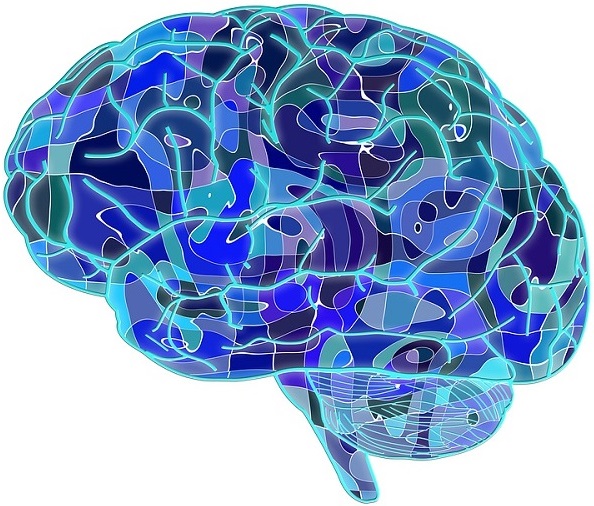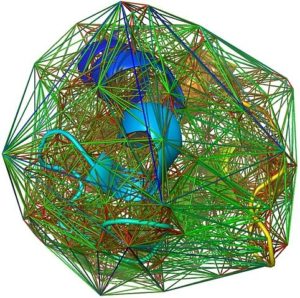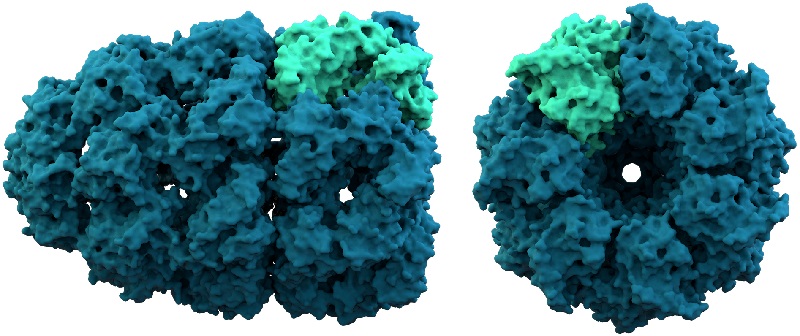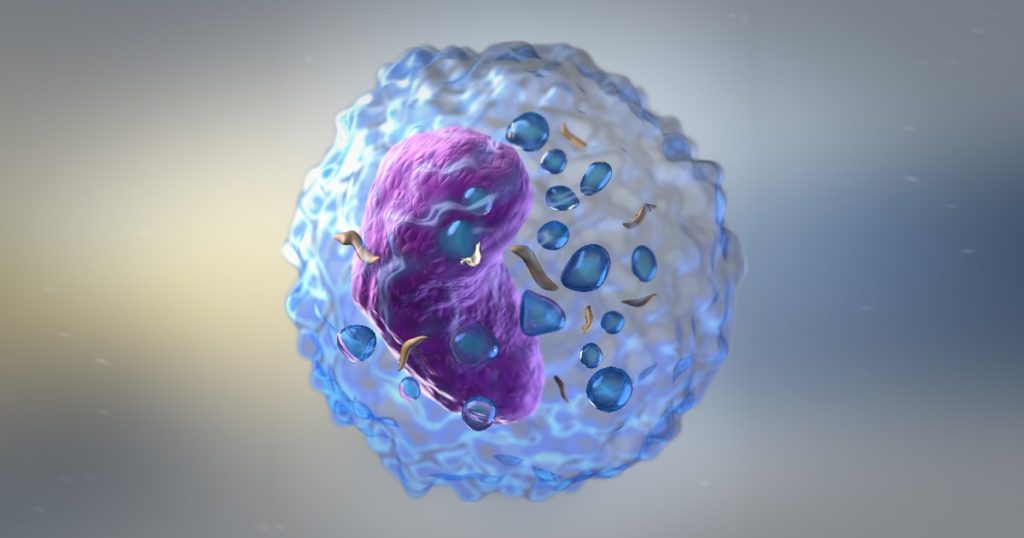Cellular Garb-aging Causes You To Age (Loss of proteostasis)
Summary: Cellular garb-aging is back in the spotlight as research shows the phenomenon plays a key role in the diseases of aging, including cancer, Alzheimer’s, Huntington’s, Parkinson’s, metabolic diseases, chronic inflammation and the aging process itself. Garb-aging is so bad for our health that researchers are looking for ways to take the garbage out, or to keep it from building up in the first place. [This article first appeared on LongevityFacts.com. Author: Brady Hartman. Follow us on Reddit | Google+ | Facebook. ]
According to researchers, we lose health and vitality because our cells fill up with junk as we age.
Scientists are looking for drugs that clean up the cellular garbage to delay aging and cure disease.
Anti-aging researchers have long recognized that ‘cellular garb-aging,’ also called the loss of proteostasis, plays a role in many of the diseases of aging, including cancer, Alzheimer’s, Huntington’s disease, amyotrophic lateral sclerosis (ALS), Parkinson’s, and metabolic diseases. For each of these diseases, some proteins misfold and aggregate, such as in pancreatic cancer, a particularly vicious tumor.
Clean up the cellular garbage, and you can not only delay aging, but you can also help cure these diseases. That’s why geroscientists are testing ways to remove problematic cellular garbage, which forms due to a breakdown in the cellular housekeeping service known as autophagy. Researchers know that autophagy and Alzheimer’s disease are closely related. The loss of autophagy leads to a build-up of junk such as the amyloid plaques that form in the brain of patients with Alzheimer’s disease.

Cellular Garb-Aging
The accumulation of junk accelerates the aging process in a phenomenon known as cellular garb-aging, an amalgam of the words garbage and aging. Garb-aging loosely means ‘accelerated aging due to the build-up of garbage inside the cells.’ The accumulate junk not only causes loss of function, but it also promotes chronic inflammation which in turn accelerates aging throughout the rest of the body. Remove the cellular garbage, and you stop cellular garb-aging.
While physicians have known about garbage inside cells for about a century, it wasn’t until modern times, that researchers started realizing that cellular garbage plays a central role in both aging and disease. The term was coined in 2016 by Claudio Franceschi in his paper titled “Inflammaging and ‘Garb-aging.’” While Franceschi came up with the phrase, he wasn’t the first scientist to document the fact that these useless clumps of protein in our cells play a role in aging. Franceschi however, added one more crime to the garb-aging’s growing rap sheet: aging-induced chronic inflammation, also known as inflammaging.
Garb-Aging Investigator
Knowing very well that garb-aging has been on crime spree causing human disease and suffering, a group of investigators has been looking for ways to stop this public menace.
Claudio Soto, Ph.D., is a neuro-researcher with the University of Texas Health Science Center at Houston (UTHSC-H). As a garb-aging investigator, of sorts, Dr. Soto studies how cellular garbage, such misfolded protein clumps in the brain lead to diseases such as Alzheimer’s, Parkinson’s and dementia. Back in a 2015 interview with The Scientist, Dr. Soto shared a widespread belief among lifespan-extension scientists, saying
“The hypothesis is that maybe there is a widespread accumulation of misfolded protein aggregates affecting all cells in the body, and that produces progressive dysfunction of cells in the body that leads to aging.”
Damaged and Misfolded Proteins Key To Cellular Garb-Aging

Our health depends on proper protein function.
Proteins don’t just form the building blocks of our skin and muscles; they also form the enzymes that govern the life-giving processes inside our bodies, from controlling our genes to digesting the foods that we eat to building new skin and blood cells. Practically every process in our cells requires the assistance of protein.
Hazards to Proteins
Our proteins face daily assaults from free radicals, toxins and other types of insults.
The proteins inside of our cells and tissues and can fall victim to all sorts of hazards, including being misfolded, abnormally glycated, oxidized by free radical damage, aggregated, and cross-linked. Because of this continual onslaught, our cells are constantly building new proteins while breaking down damaged ones.
Decline in Quality Control
As we grow older, our protein quality control and autophagy processes decline in efficiency and our cells and tissues fill up with non-functioning proteins which promote cellular senescence, inflammaging, and cell death.
Look into a microscope, you can find these dysfunctional proteins in the tissues of organs affected by age-related chronic diseases. For example, aggregated proteins both accompany and worsen many diseases, such as insulin-dependent diabetes, dilated cardiomyopathy, Alzheimer’s and Parkinson’s disease,
Our body creates new protein all the time, these must be assembled correctly, or they don’t work properly. Proper protein function is all about proper protein folding. Misfolded proteins are often rendered useless. To add insult to injury, damaged proteins can clump together with misfolded proteins, causing even more trouble.

Proteostasis Prevents Cellular Garb-Aging
To keep garb-aging from becoming a problem, our bodies have natural housekeeping processes, called proteostasis mechanisms that clean out damaged proteins and keep the other ones correctly folded. The term proteostasis is an amalgam of the words ‘proteo’ for protein and ‘homeostasis’ for balance. Our proteostasis mechanisms include molecular chaperones that ensure proper protein folding and other protective pathways that maintain the quality of protein in our cells.
Proteostasis is a collective term for the quality-control mechanisms that stability, balance, and quality of proteins. The term proteostasis is an amalgam of the words protein and homeostasis, a process that ensures. Proteostasis concerns the processes involved in the creation; folding, misfolding and aggregation; trafficking and degradation of proteins both within and without the cell. Additionally, the specialists in the field of proteostasis are concerned with how our bodies stress response mechanisms and chaperones maintain proper proteostasis.
Bottom Line: Proper proteostasis means less garb-aging. Loss of proteostasis leads to more garb-aging.

Chaperones Prevent Garb-Aging
To maintain protein homeostasis, and prevent garb-aging, the cell uses molecular chaperones, which help assemble and disassemble proteins. Chaperonins are a special class of chaperones that provide favorable conditions for the correct folding of other proteins, thus preventing aggregation. Chaperonins prevent the misfolding of proteins, which prevents conditions such as Mad Cow Disease. Sometimes, chaperonin proteins may also tag misfolded proteins to be degraded. When properly tagged, other processes can recognize the damaged or misfolded proteins and ‘take out the trash.’
Think of it as garb-aging removal.
Aging Leads to Cellular Garb-Aging
Unfortunately, advancing age brings about the decline of the molecular chaperones that aid in the folding process. To add insult to injury, we also experience a decrease in the other quality control process that help clear misfolded and damaged proteins from our cells. Our garb-aging removal processes fall to the wayside. Garb-aging takes its place.
Don’t just think these misfolded proteins just sit around in the cell and do nothing all day. These clumps of misfolded and damaged proteins called protein aggregates are active troublemakers. Not to mention their roles in diseases such as Alzheimer’s, protein aggregates can change gene expression at the transcriptional level. Garbage-like protein aggregates are intimately involved in the progression of aging, and therefore are the main villains in the process of garb-aging.
Protein aggregates are bad news.
If we could prevent these protein aggregates from causing cellular garb-aging, we could stave off a host of age-related diseases or even aging itself.
This age-related build-up of junk, termed garb-aging leads to inflammation a decline in cellular efficiency, among other things. As we age, the proteostasis system becomes burdened by damaged and oxidized proteins. The loss of proteostasis has been implicated in many age-linked diseases, including. The loss of proteostasis is double trouble: first, there is a general loss of protein quality as we age, second, the reduced housekeeping leads to a build-up of problem-causing junk proteins inside the cell.
Is Cellular Garb-Aging For Real?
For insight into the aging process, scientists often study the worm C. elegans. Research on the worm has yielded tantalizing clues regarding protein misfolding and aging. Northwestern University molecular biologist Richard Morimoto and his team showed that the worm’s proteostasis machinery starts breaking down very early on in the worm’s three-week lifespan. This is bad news for both worms and humans, unfortunately, because we have the same proteostasis machinery which includes protein-degrading enzymes, molecular chaperones, and stress-response transcription factors. Dr. Morimoto was also interviewed by The Scientist, for the same article as Dr. Soto. Supporting the theory that loss of proteostasis or cellular garbage build-up causes aging, Dr. Morimoto says,
“What’s interesting is that this [decline in proteostasis machinery] happens very early in adulthood,” adding “You see these changes within days of becoming an adult.”
Even worms are plagued by garb-aging.
Reversing Cellular Garb-Aging
If cellular garb-aging plays a key role in disease, correcting it may be a way of staving off a host of age-related diseases or even aging itself,
Dr. Soto says that the problems with protein folding might be the main culprit in a multitude of diseases that plague our aging bodies. After all, normal protein folding is necessary for gene expression, enzyme function, and a host of other crucial physiological events. Scientists cannot lay blame on any one particular process as there are many processes that cause us to age. Soto feels that protein misfolding may act as sort of a linchpin in all these different processes, saying
“This [protein misfolding] could actually unify the different processes.”
If cellular garb-aging due to protein misfolding plays a key role in aging, correcting it may be a way of warding off a host of age-related diseases or even the aging process itself. Dr. Soto added,
“The good news is that, if that’s the case, you could envision really intervening in this [protein misfolding] and delaying the aging process.”
Treatments That Reverse Cellular Garb-Aging
Scientists have already developed FDA-approved treatments that promote health by maintaining cellular proteostasis and preventing cellular garb-aging. Researchers have developed two types of therapeutic approaches are targeting the proteostasis mechanism, such as proteostasis regulators and pharmacologic chaperones.
Proteostasis regulators alter the processes of protein folding and degradation. Scientists are a long way from creating proteostasis regulators.
Pharmacologic chaperones offer more promise. In fact, many currently FDA-approved therapies are already used to treat lysosomal storage diseases. Limitation of the therapy is that it only works with certain mutations: Gaucher’s disease, Fabry disease, Pompe disease and Late-onset Tay-Sachs disease. The drug companies Amicus, Pfizer, and Vertex Pharmaceuticals sell FDA-approved pharmacologic chaperones used to treat diseases by stabilizing proteins. Vertex has a treatment for cystic fibrosis, and Pfizer has one for treating transthyretin amyloidoses. Amicus markets an FDA-approved pharmacologic chaperone for Fabry disease, a lysosomal storage disease.
Preventing Cellular Garb-Aging In Healthy Adults
In the journal article Proteostasis and aging, authors Susmita Kaushik & Ana Maria Cuervo claim that by diminishing cellular garb-aging, we can improve our health and lengthen our lives, as the authors say in their paper,
Multiple types of interventions support the idea that diminishing the proteotoxic load [improving proteostasis] during aging can improve lifespan or healthspan
The authors also make the point that autophagy improves proteostasis. Better proteostasis means less cellular garb-aging. The authors claim that known lifespan-extending interventions owe their success due to improved autophagy and proteostasis. Kaushik & Cuervo point out that the interventions known to increase lifespan, are also known to increase autophagy, such as rapamycin, calorie restriction, and metformin. The authors make it clear when they state,
“Interestingly, most of the interventions that slow down aging in experimental models are associated with improved proteostasis [reducing cellular garbage build-up], and in many instances, these interventions demonstrated autophagy-activating properties. For example, calorie restriction, rapamycin, metformin, resveratrol and spermidine, which are well known for their ability to extend lifespan and/or healthspan, have all been proven to directly activate autophagy, although probably through different mechanisms. “
Autophagy means eating oneself. During times of hardship or stress, the cell releases enzymes that allow it to digest its insides as a defensive or self-preservation measure.
The authors are partially correct about their list of life-extending compounds. They got it right with rapamycin and metformin.
For example, rapamycin has been shown to extend the lifespan of mice and is a FDA-approved immunosuppressant. Intermittent dosing of rapamycin seems to work the best and researchers have slated the drug for another clinical trial.
Studies show that metformin prevents cancer and a host of other diseases. The diabetes drug is currently in a clinical trial called TAME, as the world’s first anti-aging drug.
Regarding the other two items on their list, the evidence is lacking to support the use of resveratrol or spermidine. Most notably, resveratrol and its analogs have been a disappointment.

Can Coffee Prevent Garb-Aging?
Kaushik & Cuervo also speculated that certain dietary interventions, most notably coffee, can stimulate proteostasis. While it remains to be seen if coffee stimulates proteostasis, the authors may be on to something, as research shows that coffee has numerous health benefits. In fact, observational studies have linked coffee consumption to a longer lifespan. Most notably, other observational studies link coffee consumption to a significant decrease in Alzheimer’s and Parkinson’s, diseases characterized by a build-up of cellular garbage called amyloid plaques.
Maybe Starbucks® is selling a potent defense against garb-aging?
Bottom Line
Proteostasis mechanisms keep our cells nice and tidy. Unfortunately, these quality-control mechanisms decline with age, leading to a build-up of garbage within our cells. The accumulating junk plays a key role in disease and aging, in a phenomenon called cellular garb-aging.
Cellular garb-aging plays a role in many of the diseases of aging, including cancer, Alzheimer’s, Huntington’s, Parkinson’s, metabolic diseases, chronic inflammation and the aging process itself. Garb-aging is such a threat to our health that researchers are looking for ways to take the garbage out, or to keep it from building up in the first place.
While pharmaceutical companies have developed drugs that treat specific diseases, they are a long way off from preventing cellular garb-aging from occurring in healthy adults. Hopefully, researchers can take what they’ve learned in developing proteostasis-restoring therapies for rare diseases and leverage it into creating prophylactic treatments that treat or prevent cellular garb-aging in healthy adults.
Show Us Some Love
- One click helps us spread the word – Share this post on social media and help us spread the word. It only takes one click on any of the social media links on this page.
- Follow us on social media – For more articles, follow us on Google+ | Facebook | Reddit
- Sign up for our email list – We use your email to notify you of new articles. We will not send you spam, and we will not share your email address. You can cancel at any time.
- Tell us what you think of this article – Please scroll down and enter your comments below.
References
Claudio Franceschi, et al. Inflammaging and ‘Garb-aging.’ Trends in Endocrinology & Metabolism, Volume 28, Issue 3, 199 – 212. Available Online.
Carlos López-Otín, et al. The Hallmarks of Aging. (2013) Cell, Volume 153, Issue 6, 1194 – 1217. Available Online.
“How We Age | The Scientist Magazine®.” The Scientist Magazine. Online article. Retrieved October 1, 2017. Available Online.
Terman, U.T. Brunk. Oxidative stress, accumulation of biological ‘garbage’, and aging. Antioxidants & Redox Signaling. February 2006, 8(1-2): 197-204. http://doi.org/10.1089/ars.2006.8.197. Alternate link.
Susmita Kaushik & Ana Maria Cuervo. Proteostasis and aging. Nature Medicine 21, 1406–1415 (2015) doi:10.1038/nm.4001. Published online 08 December 2015
Disclaimer
Diagnosis, Treatment, and Advice: This article is intended for educational and informational purposes only and is not a substitute for professional medical advice. The information and opinions provided herein should not be used during any medical emergency or for the diagnosis or treatment of any medical condition. Experimental therapies carry a much higher risk than FDA-approved ones. Consult a licensed and qualified physician for the diagnosis and treatment of any and all medical conditions. Call 911, or an equivalent emergency hotline number, for all medical emergencies. As well, consult a licensed physician before changing your diet, supplement or exercise programs. Photos, Endorsements, & External Links: This article is not intended to endorse organization, companies, or their products. Links to external websites, mention or depiction of company names or brands, are intended for illustration only and do not constitute endorsements.

7 Replies to “Cellular Garb-aging Causes You To Age (Loss of proteostasis)”
Comments are closed.